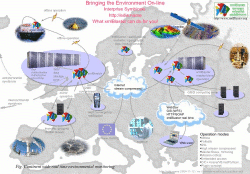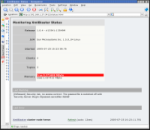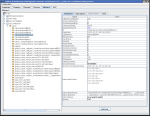Did you ever click on our rainbow fish logo?
xmlBlaster is still actively maintained, so we decided to simplify access via github
After many smaller changes und fixes (see CHANGES) it was time to release xmlBlaster v2.2.0.
And it runs and runs and runs ...
xmlBlaster is one of those backend tools doing all the hard work without whining ... most people will ever take notice of it ... got curious?
It's time to tell again about this positiv feedback of a piece of software doing quitely and persistently a brilliant job!
See the CHANGES file to find out what is new and read the RELEASE NOTES.
Try our INSTALLATION and ready to run in only 45 seconds (SUN/IBM/HP JDK 1.5/1.6/1.7)!
xmlBlaster 2.1.0 represents one of the most significant messaging middleware since the introduction of xmlBlaster half a decade ago. It offers all types of developers a wider spectrum of software integration (SOA) possibilities and a greatly advanced messaging experience. By expanding the xmlBlaster product line to include the C# Windows Mobile/PocketPC/Smartphone/iPhone client libraries and the commercially available highly compressed J2ME communication client for mobile devices, xmlBlaster 2.1.0 delivers a compelling toolset for everyone, from small scale developments to enterprise developer teams.
See the CHANGES file to find out what is new and read the RELEASE NOTES.
Try our INSTALLATION and ready to run in only 45 seconds (SUN/IBM/HP JDK 1.5/1.6)!
xmlBlaster 2.0.0 continues xmlBlaster.org coders investment in market revolution messaging tools. 2.0.0 addresses issues that were found through a combination of user and partner feedback, as well as internal usage and testing.
The Code is available on the svn main trunk.
See the CHANGES file to find out what is new and read the RELEASE NOTES.
Try our INSTALLATION and ready to run in only 45 seconds (SUN/IBM/Blackdown/HP JDK 1.4/1.5/1.6)!
See the client.c requirement.
See how xmlBlaster integrates backend services with mobile devices (phones, J2ME, PDA, Windows Mobile, iPhone, black-boxes) and with the Web. And all that with real time communication.
Go to http://watchee.net.
See the admin.checkpoint requirement.
See the CHANGES file to find out what is new and read the RELEASE NOTES.
XmlBlaster supports now managed languages like C#, managed C++ and VB.net on Windows, Mono/Linux and on Windows CE (ARM/XScale and others) using the SOCKET protocol with tunneled callbacks and zlib:stream compression.
See the client.c.windowsCE requirement.
See the engine.runlevel.howto requirement.
The two new methods
receive()
and
request()
support synchronous access with many options.
You can transparently switch for example from SSL socket to compressed email communication (preserving all failure recovery features) if for example two companies need to connect but don't want to open their firewall, see Email Configuration README.
You can now access xmlBlaster completely from within an Apache ANT build.xml file, see XmlBlasterTask API.
So please rename your existing working directory and get it new from our svn-server.
This little client allows read only access to xmlBlaster messages with a simple telnet from within a script for example to read the content of messages which are stored in the mom.
As the org.jutils java library is not maintained anymore we have now removed all dependency on it.
We have removed the older org.jutils.log from xmlBlaster and the complete logging is now done with SUNs logging framework which was introduced with JDK 1.4, see the admin.logging requirement.
Besides the short requirement a documentation for the replication has been added. It is available as multipage html and as single page html.
Online demos provided with flash have been added. As a first example we show a simple demo on replication.
Click on Online Demos or on the left navigation bar.
An extensive flexible and extensible framework can be found in the org.xmlBlaster.contrib.replication package. This framework allows you among other things to replicate data from one database of a particular vendor to one of another vendor in a portable fashion. The data can be modified, filtered and transported over the most unthinkable communication protocols. Yes you can even replicate entire databases via emails and over the most fancy firewalls and security gateways.
As always, it is unnecessary but anyway worth to say that failsafe- and correct sequence delivery are guaranteed even on unreliable communication channels.
The contrib.replication requirement shows a simple usage.
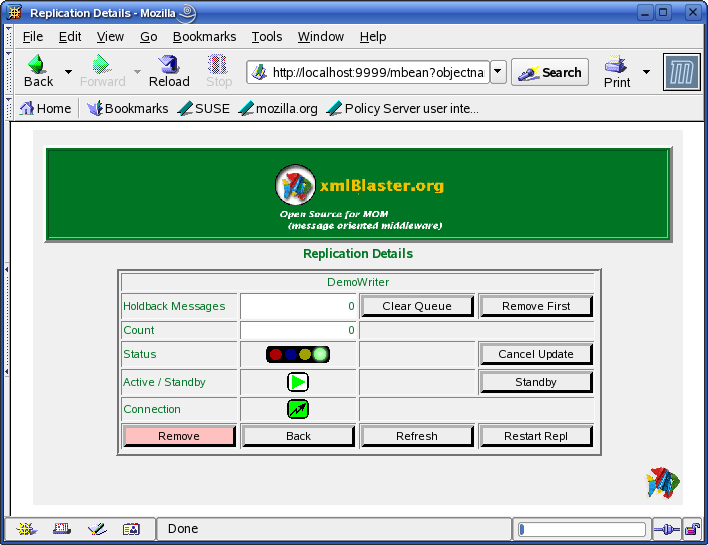
See the admin.jmx requirement for more details.
You can start the mx4j http adaptor as a plugin. This adaptor generates xml responses on http requests which can be processed/transformed with xsl stylesheets. It is quite easy to use and highly costumizable, make it an ideal approach for tailored business specific monitoring.
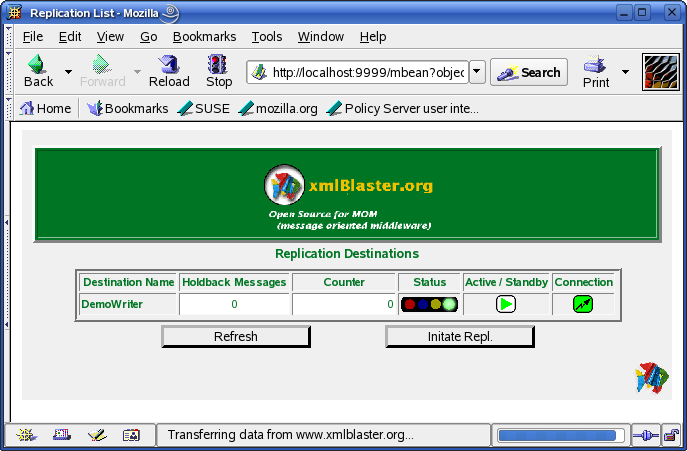
See the admin.events requirement for more details.
Administrators can use this to monitor xmlBlaster operation and to be notified about critical issues.
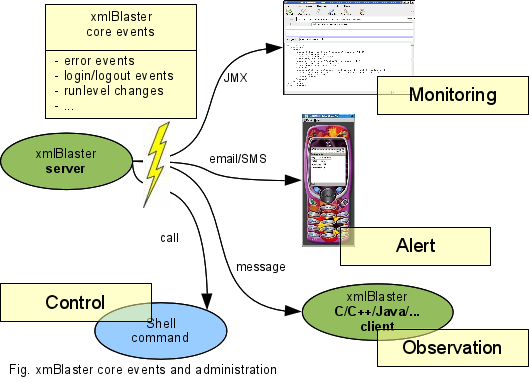
See the protocol.email requirement for more details.
You can use emails transparently instead of CORBA or XMLRPC to do the complete communication between clients and the server or you can use your favored email client (like outlook or thunderbird) to send email messages to xmlBlaster.
See the client.csharp requirement for more details.
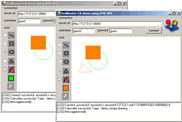
Please read the admin.http requirement for details.
Please read the queue.jdbc.firebird requirement for details.
Please read the admin.jmx requirement for details.
>>> got to older news >>>
|
